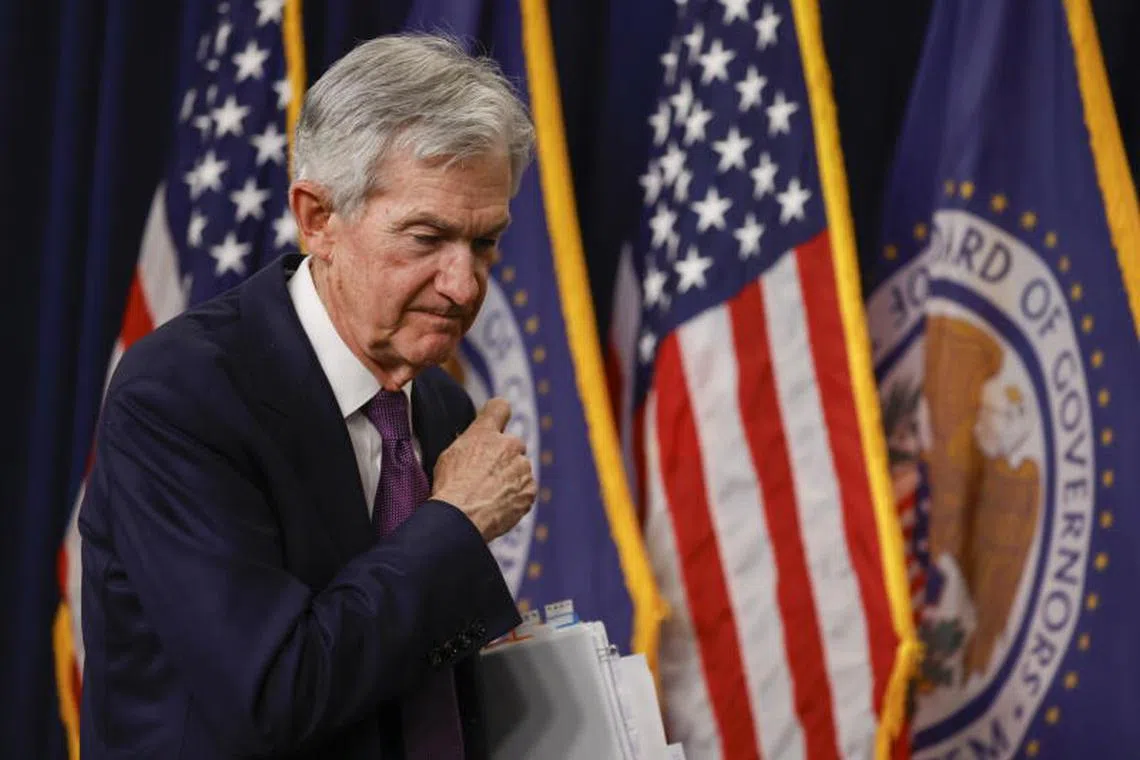US Fed lowers rates but sees fewer cuts in 2025 to fight inflation
Sign up now: Get ST's newsletters delivered to your inbox

US Federal Reserve chair Jerome Powell’s explicit – and repeated – references to the need for caution on rate cuts jolted Wall Street, sending US stocks sharply lower and the US dollar rallying.
PHOTO: EPA-EFE
Follow topic:
WASHINGTON – The US Federal Reserve cut interest rates by a quarter of a percentage point on Dec 18 but signalled a slower pace of cuts ahead, as uncertainty grows over inflation and US President-elect Donald Trump’s economic plans.
In updated economic forecasts published alongside the rate decision, members of the Fed’s rate-setting committee pencilled in just two quarter-point rate cuts in 2025, down from an earlier prediction of four.
They hiked their headline inflation outlook for 2025 from 2.1 per cent to 2.5 per cent – well above the US central bank’s 2 per cent target.
Fed chairman Jerome Powell’s explicit – and repeated – references to the need for caution on rate cuts jolted Wall Street, sending US stocks sharply lower and the US dollar rallying
“I think we’re in a good place, but I think from here it’s a new phase and we’re going to be cautious about further cuts,” Mr Powell said at a press conference following the end of the Fed’s latest two-day policy meeting.
The Fed and Mr Powell had been widely expected to deliver a “hawkish” rate cut by estimating roughly half the policy easing in 2025 than the 100 basis points policymakers had projected three months ago. But by the time Mr Powell had finished speaking, only one 25 basis-point cut for 2025 was reflected in market pricing.
As expected, the Fed lowered its policy rate by a quarter of a percentage point to the 4.25 per cent to 4.5 per cent range, a decision Mr Powell described as a “closer call”, noting that the slower pace of projected rate cuts in 2025 reflected higher inflation readings in 2024.
Indeed, the decision to cut rates drew a dissent from Cleveland Fed president Beth Hammack, who joined the central bank earlier in 2024 and indicated she would have preferred to leave rates unchanged at this week’s meeting.
“Economic activity has continued to expand at a solid pace” with an unemployment rate that “remains low” and inflation that “remains somewhat elevated”, the central bank’s rate-setting Federal Open Market Committee said in its latest policy statement.
“In considering the extent and timing of additional adjustments to the target range... the committee will carefully assess incoming data, the evolving outlook, and the balance of risks,” it said in new language that sets up a likely pause to rate cuts beginning at the Jan 28-29 meeting.
Slower progress on inflation, which is not seen returning to the 2 per cent target until 2027, translates into a slower pace of rate cuts and a slightly higher ending point of 3.1 per cent in 2027, versus the prior “terminal” rate of 2.9 per cent seen as at September.
“While the Fed opted to round out the year with a third consecutive cut, its New Year’s resolution appears to be for a more gradual pace of easing,” said Ms Whitney Watson, global co-head and co-chief investment officer of fixed income and liquidity solutions for Goldman Sachs Asset Management. She added that “we expect the Fed to opt to skip a January rate cut, before resuming its easing cycle in March”.
Trump uncertainty
The new policy rate is now a percentage point lower than the peak reached in September when officials concluded inflation was likely on the way back to the 2 per cent target and that there were risks to the job market of keeping monetary policy too tight for too long.
Key measures of inflation since then, however, have largely moved sideways, while continued low unemployment and stronger-than-expected economic growth have sparked debate among policymakers about whether monetary policy is as tight as thought.
The Fed, which hiked rates aggressively in 2022 and 2023 to combat a surge in inflation, began its easing cycle in September with a half-percentage-point cut in borrowing costs. It lowered rates by a quarter of a percentage point in November.
The latest quarterly projections are the first since Trump’s victory in the Nov 5 election, which introduced a new level of uncertainty into the economic outlook given his campaign promises for tax cuts, tariff hikes and a crackdown on unauthorised immigration – aspects of which some analysts see as inflationary.
Trump does not take office until Jan 20, and Fed officials have said they cannot base monetary policy on campaign proposals that may or may not be enacted. Still, Mr Powell said some policymakers took into account “highly conditional estimates” of effects from the incoming administration’s anticipated policies.
Fed staff have likely been gaming out different scenarios, and policymakers’ projections show growth remaining above potential at 2.1 per cent in 2025, inflation staying above target for two more years, and the jobless rate never rising above 4.3 per cent. REUTERS

